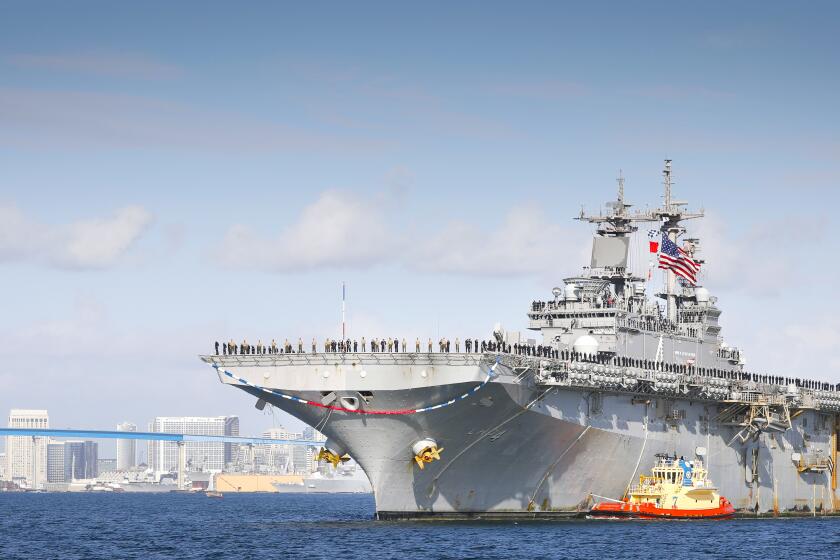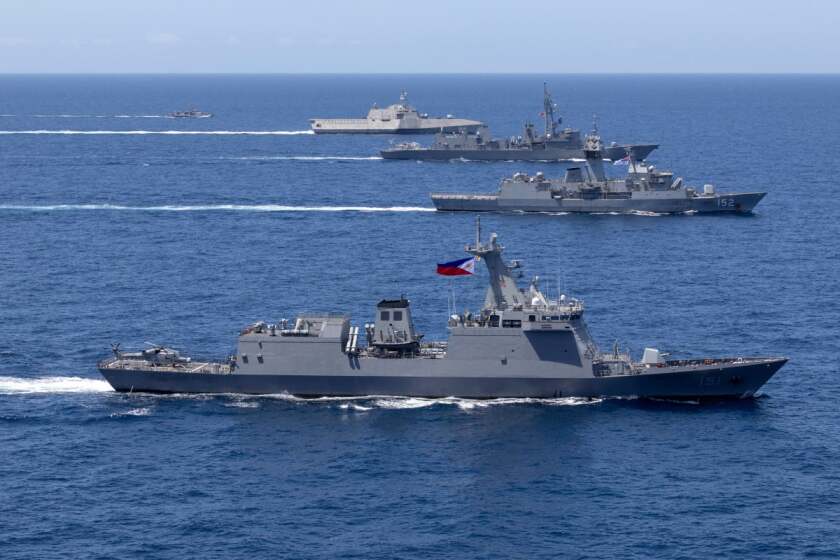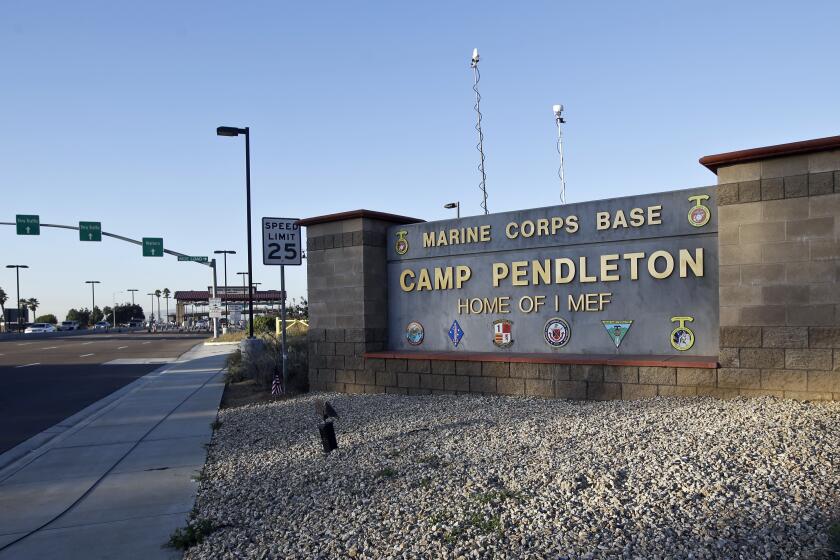Marines find fault in deadly helo crash
Maintenance issue, pilot error in Twentynine Palms mishap that killed two
Two Marines died and a Huey helicopter was destroyed early this year at Twentynine Palms because of an improperly installed part that caused a loss of oil pressure, a Marine investigation has concluded.
Another cause of the crash was the air crew’s decision to continue flying during the oil-pressure emergency, perhaps because of the mistaken belief that a faulty instrument reading was to blame, according to a copy of the investigation obtained by The San Diego Union-Tribune through a Freedom of Information Act request.
The pilot, Maj. Elizabeth Kealey, 32, of Indiana, Pa., and the co-pilot, Capt. Adam Satterfield, 25, of Oldham, Ky., died of blunt-force injuries shortly after the Jan. 23 crash at the Marine combat center.
The two-person air crew from Marine Light Attack Helicopter Squadron 169 was ferrying the UH-1Y Huey from its home base at Camp Pendleton for combat training, without crew chiefs, ordnance or passengers.
The helicopter went down about 50 minutes into the flight at 4:40 p.m., landing on bare desert ground some 500 feet from the runway at Camp Wilson. Oil pressure in the main rotor gear box had fallen to zero, the rotors stopped in flight and the aircraft plummeted 200 feet to the ground, crushing the pilots into their seats hard enough to dent the floor panels.
The tail rotor broke off as the helicopter bounced and rolled onto its side, resulting in a total loss of the $26 million aircraft.
Their deaths “were in the line of duty and were not due to their own misconduct,” according to the San Diego-based 3rd Marine Aircraft Wing. No punitive actions against any members of the squadron were recommended, but the Marine inspector who signed off on a filter cover implicated in the mishap should have his inspection credentials suspended until the squadron ensures “he is mentally prepared to continue his duties,” the report said.
“My heartfelt condolences are extended to the families and friends of Capt. Kealey and 1st Lt. Satterfield. They served their country honorably, and they will be missed by all of us,” Maj. Gen. Michael Rocco, commanding general of the air wing, said in his review of the command investigation, referring to the fallen Marines who were posthumously promoted.
MAINTENANCE
The investigator determined that oil leaked from the main rotor gear box when the cover of the 40-micron filter assembly came off during flight. The wrong sealant had been used and the filter cover improperly installed, the Marine Corps said.
Because of an inability to remove the filter housing, HMLA-169 was granted waivers for three years in a row to allow its maintainers to inspect the filter without removing it from the fuselage.
Although the waivers were not a cause of the accident, they were a contributing factor, because “It is reasonable to surmise that if the aircraft waiver was never approved and the filter assembly had been previously replaced with the correct sealant, this mishap would never have occurred.”
Previous attempts by Marine maintainers to remove the filter housing by striking it with some sort of pry bar had marked the filter housing but did not affect its structural integrity, the investigator concluded. The cover had to be replaced twice when it was broken during unsuccessful attempts to remove the filter housing.
A survey of experienced flight line Marines found that none realized the filter cover retaining ring had a top and bottom affecting installation. The survey also revealed that common methods of removing the filter housing included use of a slide hammer or overhead crane, which the investigator described as alarming since “the filter housing is not designed to withstand that type of stress.”
The phase crew collateral duty inspector, or CDI, who verified that the filter cover retaining ring was installed correctly “is partly responsible for this mishap. However, he did the best that could be expected” given the difficulty of inspecting the cover while it remained inside the aircraft, not on a workbench.
Performing the inspection under those conditions is not prohibited, but it is not advisable, the investigator said: “This was more of a design and publication procedure failure than a failure of (the CDI) to properly inspect the component.”
The investigator recommended that oversights in judgment by Marine maintainers of the helicopter should be addressed through mentorship and leadership until manuals and procedures are revised. For instance, Marine Aircraft Group 39 should work with the H-1 Fleet Support Team ”to prohibit the installation of the filter cover without removing the entire filter housing assembly.”
PILOTS IN ERROR
A few days before Kealey and Satterfield flew the Huey, the rest of their squadron and its aircraft traveled to Twentynine Palms for Integrated Training Exercise (ITX) 2-15. The doomed helicopter was held back for scheduled maintenance, which may have played a role in the crew’s mistaken assessment of the oil-pressure crisis.
The helicopter was about four miles from the runway, cruising at an airspeed of about 118 knots, when the crew first declared an emergency, citing problems with the transmission and an oil-pressure reading of zero for the main rotor gear box.
They were instructed not to fly over Marines working less than 1,000 feet away in a drone hangar. When the helicopter crashed, those Marines ran to help and pulled Satterfield from the wreckage before the airfield’s emergency personnel arrived.
A low oil pressure warning for the rotor gear box went off a little more than 15 minutes before the helicopter crashed, the investigator concluded. According to warnings in NATOPS manuals, a loss of oil pressure in the main rotor gear box “will render the helicopter unflyable within 15 minutes.”
The air crew should have landed as soon as possible, according to procedures, since a major rupture in the system would cause the nearly five gallons of oil in the gear box to be expelled in about 20 seconds.
Instead, Kealey and Satterfield continued flying toward Twentynine Palms. If they had diverted to the Palm Springs or Yucca Valley airfield, they would have landed safely about eight or nine minutes before the helicopter became inoperable, Marine officials said.
“The pilots placed too much emphasis on getting the aircraft to where the squadron maintenance was operating from and not enough on complying with procedures,” the investigator concluded.
Kealey was an experienced pilot with more than 1,600 flight hours during her career, including more than 600 in H-1 aircraft and more than 800 in the CH-46 Battle Phrog. Satterfield, the co-pilot, had been designated a pilot qualified to fly the UH-1Y less than two months before the crash.
The fact that the helicopter had recently had the pressure sensor in the main rotor gear box replaced in days prior and other repairs may have “greatly influenced” their fatal error in judgment to keep flying.
Kealey had calmly requested avionics troubleshooters to standby on their arrival. “This is indicative of a pilot who thinks they have an instrument indication problem, not one that has a full-blown emergency on their hands.”
Another factor might have been unfamiliarity with the oil pressure system.
The helicopter's oil pressure fluctuated briefly and dropped to zero about 34 minutes into the flight. Because of the design of “wet bulb temperature system” the drop in pressure caused the oil temperature to steadily decline.
Someone unfamiliar with this system may have expected the oil temperature to rise when a leak occurs, the investigation notes, and this air crew was flying without crew chiefs who could have tried to verify whether a true emergency was underway.
Both pilots were "outstanding officers and talented helicopter pilots," Lt. Col. James M. Isaacs, their commanding officer, said in a statement released shortly after the crash. "Our heartfelt thoughts and prayers go out to the families and loved ones of our fallen Vipers, and we stand poised to support them in this tragedy."
Kealey, who also served as a weapons training instructor, joined the Marines in 2005. She deployed twice with the 13th Marine Expeditionary Unit and once to Afghanistan during Operation Enduring Freedom.
Her awards include the Air Medal with three Strike/Flight awards and a Navy achievement medal with a gold star.
Satterfield joined the Marines in 2011. He supported Marine Air-Ground Task Force training operations in addition to his flight duties as a pilot.
Get Essential San Diego, weekday mornings
Get top headlines from the Union-Tribune in your inbox weekday mornings, including top news, local, sports, business, entertainment and opinion.
You may occasionally receive promotional content from the San Diego Union-Tribune.





